|
|
| Übersicht – Contents: | |
Diese Seite ist Teil des Projektes
|
|
| Übersicht – Contents: | |
Flagge – Flag: |
|
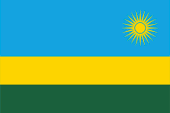 |
seit/since 2002, Nationalflagge – national flag, Seitenverhältnis – ratio = 2:3 Quelle/Source, nach/by: World Statesmen, Wikipedia (EN)   |
historische Flaggen – historical Flags: |
|
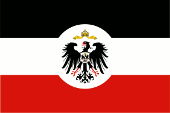 |
1898–1916, Deutsches Reich – German Empire, Dienstflagge Kolonialamt – official flag of colonial office, Seitenverhältnis – ratio = 2:3, Quelle/Source, nach/by: Wikipedia (DE)    |
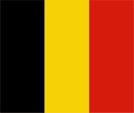 |
1916–1962, Ruanda-Urundi, Mandatsverwaltung - Mandate administration, Flagge von Belgien – flag of Belgium, Seitenverhältnis – ratio = 13:15, Quelle/Source, nach by: Wikipedia (EN)    |
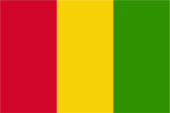 |
1959–1961, Nationalflagge – national flag, Seitenverhältnis – ratio = 2:3 Quelle/Source, nach/by: World Statesmen   |
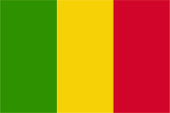 |
1961–1962, Nationalflagge – national flag, Seitenverhältnis – ratio = 2:3 Quelle/Source, nach/by: World Statesmen   |
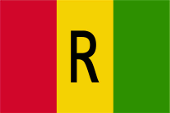 |
Jul. 1962–31. Dec. 2001, Nationalflagge – national flag, Seitenverhältnis – ratio = 2:3 Quelle/Source, nach/by: Wikipedia (EN) |
| Die heutige Flagge von Ruanda wurde am 01.01.2002 eingeführt, zusammen mit einem neuen Wappen und einer neuen Hymne. Auf diese Weise sollte nach den Massakern zwischen April und Juli 1994 ein Neuanfang symbolisiert werden, denen bis zu 900.000 Tutsi aber auch einige Hutu zum Opfer fielen. Die Flagge zeigt drei horizontale Streifen im Verhältnis 2:1:1 in Blau, Gelb und Grün und eine gelbe Sonne in der wehenden Oberecke. | The today’s flag of Rwanda was introduced on 1st of January in 2002, together witt a new coat of arms and a new national anthem. This was intended to symbolise a new beginning after the massacres between April and July 1994, which claimed the lives of up to 900.000 Tutsis but also some Hutus. The flag shows three horizontal stripes in the ratio 2:1:1 in blue, yellow and green and a yellow sun in the waving upper corner. |
| Die wahrscheinlich nicht genau festgelegten Farben Blau, Gelb und Grün sollen die ruandischen Völker Hutu, Tutsi und Batwa und deren friedliches Zusammenleben symbolisieren. Es gibt auch folgende Interpretation: Hellblau steht für Glück und Frieden, Gelb symbolisiert wirtschaftliche Entwicklung und Grün symbolisiert die Hoffnung auf Wohlstand. Die gelbe Sonne steht für Erleuchtung. Die in der Praxis zu findenden Farbtöne könnten interpretiert werden als: Hellblau = Pantone 299, Gelb = Pantone 116 und Grün als Pantone 7483. Das Format der Flagge wird mit 2:3 angegeben, es wird aber auch von Flaggen in 1:2 berichtet. | The
probably not exactly defined colours blue, yellow and green should symbolize the Rwandan peoples of the
Hutu, Tutsi and Batwa and their peaceful cohabit. There is also the
following interpretation: Light blue stands for fortune and peace, yellow
symbolises economic development and green symbolises hope for prosperity.
The yellow sun stands for enlightenment. The shades found in practice could be interpreted as: Light Blue = Pantone 299, Yellow = Pantone 116 and Green as Pantone 7483. The side ratio of the flag is given in 2:3 but there are reports about flags in 1:2 too. |
| Als im Jahre 1959 in Ruanda – das noch immer unter belgischer Verwaltung stand – Kämpfe zwischen den Hutu und dem Königtum der Tutsi ausbrachen, schufen sich die Hutu eine inoffizielle Flagge. Diese zeigte drei senkrechte Streifen in den Farben Rot, Gelb und Grün. Sie war der französischen bzw. belgischen Trikolore nachgestaltet. | As in the year 1959 in Rwanda – which was still under Belgian administration – broke out struggles between the Hutu and the kingship of the Tutsi the Hutu created for their own an unofficial flag. This showed three vertical stripes in thr colours red, yellow and green. It was designed after the pattern of the French resp. Belgian tricolour. |
| Die Hutu setzten sich in den Wirren des Bürgerkriegs durch und am 28.01.1961 wurde die Republik proklamiert. Der Tutsi-König Kigéri V. wurde für abgesetzt erklärt und nach Burundi vertrieben. Die Flagge wurde mit der ungekehrten Farbreihenfolge grün-gelb-rot als Flagge der Republik übernommen, vielleicht auch um Verwechslungen zu vermeiden (Guinea verwendete eine identische Flagge). Im Juli 1962 kehrte man aber zu rot-gelb-grün zurück, jedoch wurde in der Mitte des gelben Streifens ein großes schwarzes "R" ergänzt, vermutlich um wieder Verwechslungen zu vermeiden (Mali verwendet eine identische Flagge). Das "R" stand zuerst für "Rwanda", aber auch für "Referendum" und "Revolution". Am 01.07.1962 erklärte Ruanda seine Unabhängigkeit, die belgische Verwaltung endete. Die rot-gelb-grüne Flagge mit dem "R" wurde weiterverwendet und bis zum 01.01.2002 beibehalten. |
The Hutu prevailed in the
turmoil of the civil war and the republic was proclaimed on 28.01.1961. The
Tutsi king Kigéri V was declared deposed and expelled to Burundi. This flag was adopted as the Republic's flag with the reverse colour sequence green-yellow-red, perhaps also to avoid confusion (Guinea used an identical flag). In July 1962, however, they reverted back to red-yellow-green, but a large black "R" was added to the centre of the yellow stripe, presumably again to avoid confusion (Mali uses an identical flag). The "R" first stood for "Rwanda", but also for "referendum" and "revolution". On 1st of July in 1962, Rwanda declared its independence and Belgian administration ended. The red-yellow-green flag with the "R" continued to be used and was retained until 1st of January in 2002. |
| Die Farben Rot, Gelb und Grün sind auch als die "Panafrikanischen Farben" bekannt: Etwa 1900 setzte die Panafrika-Bewegung ein, die Gemeinsamkeiten aller Menschen mit schwarzer Hautfarbe hervorheben wollte. Der Farbendreiklang Grün-Gelb-Rot, den viele afrikanische und auch amerikanische Staaten nach Erlangung ihrer Unabhängigkeit in ihre Flaggen übernahmen, steht für die politische Einheit Afrikas, ja aller Schwarzen. Das erste Land war Ghana im Jahr 1957. Als Ursprung gelten die Landesfarben von Athiopien, dem ältesten unabhängigen Staat Afrikas. | The
colors red, yellow and green are even known as the "Panafrican colors":
Perhaps in 1900 was the beginning of the Panafrica-Movement, wich wants to
emphasize the commons of all people with black skin.
The colour-triad green-yellow-red, wich used many african and even american
countries in their flags after the independence, stands for the political
unity of Africa, of all black People. |
| Die Einführung der heutigen Flagge bedeutete für Ruanda offenbar den Abschied von den Ideen und Idealen des Panafrikanismus, da die panafrikanischen Farben nicht mehr verwendet werden. | The
introduction of the today's flag implys obviously for Rwanda the farewell
from the ideas and ideals of Pan-Africanism, because the Pan-African colours
are not in use anymore. |
|
Quelle/Source: Die Welt der Flaggen, Flaggen Enzyklopädie, Wikipedia (EN), Volker Preuß |
|
Wappen – Coat of Arms: |
|
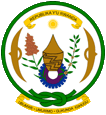 |
Wappen von Ruanda – coat of arms of Rwanda, Quelle/Source, nach/by: Wikipedia (DE) |
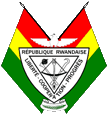 |
1962–2002, Wappen von Ruanda – coat of arms of Rwanda, Quelle/Source, nach/by: Wikipedia (EN) |
| Das heutige Wappen von Ruanda (eigentlich ein Siegel) wurde – zusammen mit einer neuen Flagge und einer neuen Hymne – am 01.01.2002 eingeführt. | The today’s coat of arms of Rwanda (actually a seal) was intoduced – together with a new flag and a new anthem – on the 1st of February in 2002. |
| Das Wappen zeigt nationale, afrikanische Elemente, einen Korb und zwei Schilde, aber auch ein Zahnrad, eine Sorghum-Pflanze, eine Kaffee-Pflanze und nicht zuletzt die Sonne, die auch in der Flagge erscheint. | The coat of arms shows national, african elements, a basket and two shields, even a cogwheel a Sorghum plant, a coffee plant and not finally the sun, which appears in the flag too. |
|
Das Wappen zeigt ferner im oberen Teil ein goldenens Spruchband mit dem
Namen des Staates in der Sprache Kinyarwanda: "Republika Y'U Rwanda",
unterhalb ein goldenes Spruchband mit dem Motto des Landes: "Ubumwe,
Umurimo, Gukunda Igihugu" → "Einheit, Arbeit, Patriotismus". Die beiden Schilde symbolisieren den Patriotismus, die Verteidigung der nationalen Souveränität, aber auch Redlichkeit und Gerechtigkeit. Der grüne Ring, der das Wappen umgibt und in einem Knoten am unteren Ende endet steht für industrielle Entwicklung durch gemeinsame Anstrengungen. |
The coat of arms shows furthermore in the upper part a golden banner with
the name of the state in Kinyarwanda language: "Republika Y'U Rwanda", below
a golden banner with the motto of the country: "Ubumwe, Umurimo, Gukunda
Igihugu" → "Unity, Work, Patriotism". The both shields symbolize the patriotism, the defense of the national sovereignty but even honesty and justice. The green ring wich surrounds the coat of arms and ends in a knot at the underneath end stands for industrial development by common efforts. |
|
Das zwischen dem 01.07.1962 (Tag der Unabhängigkeit) und dem 01.01.2002
gültige Wappen zeigte ein Wappenschild mit Hacke, Sichel, Pfeil und Bogen,
sowie dem Landesnamen und dem Motto des Landes in französischer Sprache. Das
Motto: "Liberté, Cooperation, Progrès" → "Freiheit, Zusammenarbeit,
Fortschritt". Eine Taube und ein Ölzweig oberhalb und unterhalb des Schildes standen für Frieden, die Werkzeuge repräsentierten die Arbeit und die Waffen die Verteidigungsbereitschaft. Im Hintergrund zwei rot-gelb-grün gestreifte Flaggen. |
The between the 1st of July in 1962 (day of independence) and the 1st of
January in 2002 valid coat of arms showed a blazon with hoe, sickle, arrow
and bow, as well as the name and the motto of the country in French
language. The motto: "Liberté, Cooperation, Progrès" → "Freedom,
Cooperation, Progress". A pigeon and a oil twig above and below the shield stood for peace, the tools represented the work and the arms the readiness for defense. In the background two red-yellow-green striped flags. |
|
Quelle/Source: Wikipedia (EN), Volker Preuß |
|
Landkarte – Map: |
Lage – Position: |
Landkarte des Landes – Map of the Country: |
|
|
| Zahlen und Fakten – Numbers and Facts: | |
|
|
|
|
|
|
|
|
|
|
|
|
|
|
|
|
|
|
| Antike ·
Besiedlung durch Stämme der Twa ca. 900 · Einwanderung durch Landwirtschaft betreibende Stämme der Bantu (Hutu, Kiga), Herausbildung kleinerer lokaler Königreiche ca. 1400 · Einwanderung der Großvieh züchtenden Tutsi ca. 1500 · Beginn der Unterwerfung der Bantu-Königreiche durch die Tutsi, Schaffung eines Tutsi Königreichs mit strikter Rassentrennung in nahezu ganz Ruanda, parallele Entwicklungen gibt es außer in Ruanda im gesamten Gebiet zwischen Victoriasee und Tanganjikasee (Hima-Staaten) 1884 · Erwerbung von privatem deutschen Kolonialbesitz durch Dr. Carl Peters an der Küste Ostafrikas 1885 · Gründung der Deutsch-Ostafrikanischen Kolonialgesellschaft (DOAG), das Deutsche Reich unterstellt die privat erworbenen Kolonialgebiete in Ostafrika seinem Schutz 1885 · Kongovertrag, u.a. Festlegung europäische Kriege nicht auf die Kolonialgebiete in Afrika auszudehnen 1890 · der deutsch-britische Helgoland-Sansibar-Vertrag unterstellt das Gebiet des Königreichs Ruanda dem Deutschen Reich (zu Deutsch-Ostafrika) 01.01.1891 · die DOAG überträgt dem Deutschen Reich die volle Souveränität über Deutsch-Ostafrika 1894 · Graf Gustav Adolf von Götzen besucht das Königreich Ruanda 1898 · Schutzvertrag zwischen dem Mwami von Ruanda (König von Ruanda) und dem Deutschen Reich, das Königreich Ruanda bleibt in der deutschen Kolonialzeit bestehen und wird nur der deutschen Oberhoheit unterstellt, das Königtum wird von den Deutschen unterstützt und gestärkt 1914–1918 · Erster Weltkrieg: August 1914: Großbritannien eröffnet entgegen den Vereinbarungen des Kongovertrags Feindseeligkeiten gegen Deutsch-Ostafrika, Rückzug und Abdrängung der Deutschen Verteidigungskräfte, 1916: belgische Truppen besetzen das Königreich Ruanda, 17.09.1916: die deutschen Verteidigungskräfte räumen Tabora, 25.11.1917: General Lettow-Vorbeck weicht mit seinen Truppen nach Portugiesisch-Ostafrika aus, September 1918: Lettow-Vorbeck betritt mit seinen Truppen wieder Deutsch-Ostafrika, Oktober 1918: Lettow-Vorbeck weicht mit seinen Truppen nach Britisch-Rhodesien aus, 11.11.1918: das Deutsche Reich kapituliert, 25.11.1918: General Lettow-Vorbeck kapituliert auf Befehl der deutschen Regierung in Abercorn (Britisch-Rhodesien) 1920 · Versailler Diktat, das Deutsche Reich verliert alle seine Kolonien, Deutsch-Ostafrika wird zwei Mandatsgebiete des Völkerbundes aufgeteilt: 1.) Tanganjika, unter Mandat Großbritanniens, 2.) Ruanda-Urundi (Vereinigung von Ruanda und Burundi) unter Mandat Belgiens 1921 · Einführung der Monokulturen Kaffeee und Baumwolle durch Belgien, Einsetzen starker christlicher Missionierung 1943/1944 · Hungersnot 1946 · Auflösung des Völkerbunds, Ruanda-Urundi wird UNO-Treuhandgebiet unter belgischer Verwaltung 1959 · Spannungen zwischen Hutu und Tutsi 1960 · Wahlen, sieg der Hutu-Partei Januar 1961 · Absetzung und Vertreibung des Mwami (König) der Tutsi Kigéri V., Proklamation der Republik, Flucht und Vertreibung von 60.000 Tutsi nach Burundi 01.07.1962 · Auflösung der Union mit Burundi, Proklamation der Unabhängigkeit 1963 · von Uganda aus dringt eine Rebellenarmee aus Exil-Tutsi in Ruanda ein, sie wird zurückgeschlagen 1990 · von Uganda aus dringt erneut eine Rebellenarmee aus Exil-Tutsi in Ruanda ein (Front Patriotique Rwandais - FPR), Bürgerkrieg 1991 · neue Verfassung, einige Zugeständnisse an die Tutsi-Minderheit, der Bürgerkrieg geht weiter 1993 · eine UNO-Friedenstruppe wird stationiert April 1994 · Präsident Habyarimana – ein Hutu – stirbt bei einem Flugzeugabsturz April 1994–Juni 1994 · Massenmord der Hutu an den Tutsi, ca. 900.000 Menschen werden massakriert Juli 1994 · die Tutsi-Rebellen der FPR besetzen Bujumbura, Bildung einer Übergangsregierung von Hutu und Tutsi 2000 · Paul Kagame, Chef der FPR, ein Tutsi, wird Präsident 2003 · neue Verfassung |
| Antiquity
· settlement by Twa tribes ca. 900 · immigration by farming tribes of the Bantu (Hutu, Kiga), establishment of samaller local kingdoms ca. 1400 · immigration of the cattle-breeding Tutsi ca. 1500 · onset of the subjection of the Bantu kingdoms by the Tutsi, establishment of a Tutsi-Kingdom with strict racial segregation in nearly whole Rwanda, parallel evolutions take place except in Rwanda in the whole area between Victoria Lake and Tanganjika Lake (Hima States) 1884 · purchase of private German colonial possessions by Dr. Carl Peters at the coast of East Africa 1885 · foundation of the German East African Colonial Company (DOAG), the German Empire subordinates the private purchased colonial areas in East Africa under its protection 1885 · Congo Treaty, among others arrangement to transfer European wars not to the colonial territories in Africa 1890 · the German-British Helgoland-Zansibar-Treaty subordinates the region of the Kingdom of Rwanda the German Empire 1st of January 1891 · the DOAG transfers the full sovereignty over German East Africa to the German Empire (to German East Africa) 1894 · Count Gustav Adolf von Götzen visits the Kingdom of Rwanda 1898 · protectorate treaty between the Mwami of Rwanda (King of Rwanda) and the German Empire, the Kingdom of Rwanda exists further within the German colonial times and becomes only subordinated under the German supremacy, the kingship becomes supported and strengthend by the Germans 1914–1918 · First World War: August 1914: Great Britain begins to struggle German East Africa in contradiction to the agreements of the Congo Treaty, withdrawal and push aside of the German defence forces, 1916: Belgian troops occupy the Kingdom of Rwanda, 17th of September 1916: the German defence forces leave Tabora, 25th of November 1917: General Lettow-Vorbeck avoids with his troops to Portugese East Africa, September 1918: Lettow-Vorbeck enters with his troops German East Africa again, October 1918: Lettow-Vorbeck avoids with his troops to British Rhodesia, 11th of November 1918: the German Empire surrenders, 25th of November 1918: General Lettow-Vorbeck capitulates under orders of the German government in Abercorn (British Rhodesia) 1920 · Versailles Dictate, the German Empire loses all its colonies, German East Africa becomes separated in two mandates of the League of Nations: 1.) Tanganjika, under the mandate of Great Britain, 2.) Rwanda-Urundi (unification of Rwanda and Burundi) under the mandate of Belgium 1921 · introduction of the mono-cultures of coffee and cotton by Belgium, onset of a potent christian mission 1943/1944 · famine 1946 · dissolution of the League of Nations, Rwanda-Urundi becomes a UN trust territory under Belgian administration 1959 · tensions between Hutu and Tutsi 1960 · elections, victory of the Hutu-Party January 1961 · dismissal and expulsion of the Mwami (King) of the Tutsi Kigéri V., proclamation of the republic, flee and expulsion of 60.000 Tutsi to Burundi 1st of July 1962 · dissolution of the union with Burundi, proclamation of independence 1963 · from Uganda invades a rebel army consisting of exiled Tutsi in Rwanda, it becomes repulsed 1990 · from Uganda invades once more a rebel army consisting of exiled Tutsi in Rwanda (Front Patriotique Rwandais - FPR), civil war 1991 · new constitution, some concessions to the minority of the Tutsi, the civil war continues 1993 · a UNO Peace-Unit gets stationed April 1994 · president Habyarimana – a Hutu – dies on the occasion of a plane crash April 1994–June 1994 · mass homicide of the Hutu against the Tutsi, ca. 900.000 humans become massacred July 1994 · the Tutsi rebels of the FPR occupy Bujumbura, formation of a provisional government consisting of Hutu and Tutsi 2000 · Paul Kagame, head of the FPR, a Tutsi, becomes president 2003 · new constitution |
| Quelle/Source: Atlas zur Geschichte, World Statesmen, Wikipedia (EN), Volker Preuß |